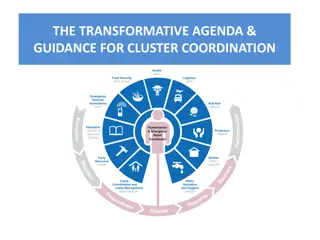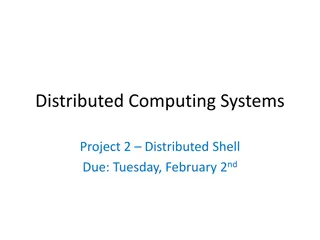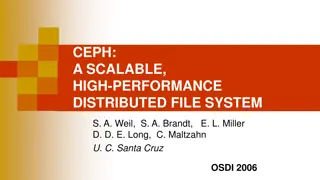Distributed and Cluster Computing Overview
Distributed computing involves executing programs across multiple connected computers, like in peer-to-peer (P2P) networks. Each computer acts as both a client and server. This method offers advantages such as easy setup and cost-effectiveness, but faces challenges like network security risks. On the other hand, cluster computing integrates standalone computers into a single entity for faster computational speed and improved data integrity.
Download Presentation

Please find below an Image/Link to download the presentation.
The content on the website is provided AS IS for your information and personal use only. It may not be sold, licensed, or shared on other websites without obtaining consent from the author. Download presentation by click this link. If you encounter any issues during the download, it is possible that the publisher has removed the file from their server.
E N D
Presentation Transcript
Distributed Computing A method of computing in which program is executed across two or more computers that are connected on a common network. Types of Distributed Computing P2P: It is ad-hoc network of couple of computers to share resources. In a P2P network, each computer is both a file server and client
P2P Peer-to-peer (P2P) computing or networking is a distributed application architecture that partitions tasks or workloads between peers. Peers are equally privileged, equipotent participants in the application. They are said to form a peer-to-peer network of nodes.
P2P In computer science, a client is a computer program that sends a request to another program to perform its actions. The server is a program that receives requests from clients and processes them. By processing the client s request, the client can subsequently execute its actions. In a peer-to-peer system, every computer in the network is both client and server. Each computer may send requests or respond to requests and process them. In other words, in a P2P system, there is no central server.
Advantages of P2P Easy to set-up No need for dedicated server Less expensive Time saving: less time in the configuration and implementation of P2P. Any computer on the network can function as both a network server and a user workstation
Disadvantages of P2P Network security Computers connected on a P2P can be accessed anytime by any member No centralized server to manage and control the network. Each computer needs to be backed up separately.
Cluster Computing Cluster Computing: Network of Independent standalone computers that works as single integrated resource. Cluster computing refers that many of the computers connected on a network and they perform like a single entity. Each computer that is connected to the network is called a node.
Cluster Computing Cluster computing offers solutions to solve complicated problems by providing faster computational speed, and enhanced data integrity Features of Cluster computing All the connected computers are the same kind of machines They are tightly connected through dedicated network connections All the computers share a common home directory.
Types of Cluster Computing Cluster Load Balancing: These clusters are built to handle large volume of client requests using multi-tasking and multi-users environments. Load balancing can either be software-based or hardware-based. Software- based load balancing uses special software on servers to manage the load based on different algorithms. Whereas, hardware-based load balancing uses specialized switches or routers to balance the load.
Types of Cluster Computing High-availability clusters: They are meant to support server applications and are maintained with a minimum down-time. Redundant computers are harnessed in a cluster to maintain high level of reliability and to maintain the down time. High performance computing clusters: This networking approach utilizes supercomputers to resolve complex computational problems. The jobs are submitted to clusters for execution and cluster will manage the resources required for the job.
Advantages of Cluster Computing Cost efficacy Processing speed Extended resource availability: When one node gets failed, the other nodes will be active and will function as a proxy for the failed node. This makes sure for enhanced availability. Expandability Flexibility: Cluster computing can be upgraded to the superior specification or extended through the addition of additional nodes (computer systems).
Applications of cluster computing It can be implemented in weather modeling Stands as support in-vehicle breakdown and nuclear simulations Used in image processing and in electro-magnetics too Perfect to be used in the applications of astrophysics, aerodynamics and in data mining Assist to solve complex computational problems Holds the flexibility to allocate workload as small data portions and which is called grid computing. Cluster computing has the capacity to function in many web applications such as Security, Search Engines, Database servers, web servers, proxy, and email. There are life savior applications through this approach like they can forecast the occurrence of earthquakes or tornadoes.
Utility computing This concept is derived from the utility services models for electricity and water as computing has also become essential part of life style and is to be consumed on need basis. Examples of Utility computing: Grid Computing and cloud computing 1. Grid Computing: It is a network of computing spread across locations to achieve a common goal. The computer on a grid network usually work on a task together resulting in a power similar to supercomputer. Advantages of Grid computing: - Low investment - Efficient and effective use of idle IT infrastructure.
Utility computing - Faster solutions to complex and large problems. - More scalable and robust - Parallel processing mode for execution of job. Disadvantage of grid computing - Political challenges associated with sharing resources. - Requires fast and reliable network - Standards are still evolving
Cloud Computing Cloud computing is the delivery of different services through the Internet. These resources include tools and applications like data storage, servers, databases, networking, and software. Information is found remotely in the cloud or on a virtual space. Companies that provide cloud services enable users to store files and applications on remote servers and then access all the data via the Internet. This means the user is not required to be in a specific place to gain access to it, allowing the user to work remotely.
Types of Cloud Services Email Storage, backup, and data retrieval Creating and testing apps Analyzing data Audio and video streaming Delivering software on demand
Characteristics of Cloud computing On-demand usage/flexibility: These can be used almost instantly and can easily be scaled up and down. External data storage: A customer s data is usually stored externally at the location of the cloud computing vendor. Multi-tenancy: It resources are shared between different users and customers. Rented service delivery model: Customers pay for the service instead of buying software licenses and hardware.
Advantages of cloud computing 1. Security: A cloud host's full-time job is to carefully monitor security from external and as well as internal threat to data, which is significantly more efficient than a conventional in- house system. RapidScale claims that 94% of businesses saw an improvement in security after switching to the cloud, and 91% said the cloud makes it easier to meet government compliance requirements. Dell reports that companies that invest in big data, cloud mobility, and security enjoy up to 53% faster revenue growth than their competitors. 2. Cost Savings: It eliminates the capital expenditure by allowing the customers to move from CAPEX to OPEX.
Advantages of cloud computing 3. Flexibility: A cloud-based service can meet that demand instantly, rather than undergoing a complex (and expensive) update to your IT infrastructure. This improved freedom and flexibility can make a significant difference to the overall efficiency of your organization. 4. Reliability: Cloud systems are more reliable as they take care of disaster recovery, business continuity and data backups, etc.
Advantages of cloud computing 5. Mobility: Cloud computing allows mobile access to corporate data via smartphones and devices. Through the cloud, information is accessible to sales staff who travel, freelance employees, or remote employees, for better work-life balance, and also in case of emergencies like lockdown due to emergency (CORONA). Therefore, it's not surprising to see that organizations with employee satisfaction listed as a priority are up to 24% more likely to expand cloud usage. 6. Performance: All latest resources are made available that drastically improve the performance and also take care of obsolescence.
Advantages of cloud computing 7. Quality Control: All documents are stored in one place and in a single format. With everyone accessing the same information, you can maintain consistency in data, avoid human error, and have a clear record of any revisions or updates. 8. Disaster Recovery: Cloud-based services provide quick data recovery for all kinds of emergency scenarios, from natural disasters to power outages. While 20% of cloud users claim disaster recovery in four hours or less, only 9% of non-cloud users could claim the same. In a recent survey, 43% of IT executives said they plan to invest in or improve cloud-based disaster recovery solutions.
Types of cloud based deployment models 1. Public Cloud: These are available to the general public and data are created and stored on third-party servers. As server infrastructure belongs to service providers that manage them and administer pool resources, the need for user companies to buy and maintain their own hardware is eliminated. Provider companies offer resources as a service on a free of charge or pay-per-use basis via the Internet connection. Users can scale them when required. Examples are Amazon Elastic Compute, Google AppEngine, IBM s Blue, Microsoft Azure, Salesforce Heroku and others.
Types of cloud based deployment models The pros of a public cloud are: - Unsophisticated setup and use - Easy access to data - Flexibility to add and reduce capacity - Cost-effectiveness - Continuous operation time - 24/7 upkeep - Scalability - Eliminated need for software The cons of a public model: - Data security and privacy - Compromised reliability - The lack of individual approach
Types of cloud based deployment models Private Cloud: Only one specific company owns a private cloud, which is why it is also called internal or corporate. Because these data center architectures reside within the firewall, they provide enhanced security. Even though one organization runs its workloads on a private basis, a third party can also manage it, and the server can be hosted externally or on-premises of the user company. Only a clearly defined scope of persons have access to the information kept in a private repository, preventing the general public from using it. In light of numerous breaches, a growing number of large corporations decided on a closed private type as it is expected to be less risky
Types of cloud based deployment models Advantages of a private model: Individual development Storage and network components are customizable High control over the corporate information High security, privacy and reliability Disadvantage of the private cloud deployment model: cost intensiveness, as it entails considerable expenses on hardware, software and staff training.
Types of cloud based deployment models Community Cloud: Several organizations with similar background share the infrastructure and related resources. As the organizations have uniform security, privacy and performance requirements, this multi-tenant data center architecture helps companies achieve their business-specific objectives. That is why a community model is particularly suited for organizations that work on joint projects.
Types of cloud based deployment models Advantages of a community computing Cost reduction Improved security, privacy and reliability Ease of data sharing and collaboration Disadvantages of a community computing Higher cost than that of a public one Sharing of fixed storage and bandwidth capacity It is not widespread so far
Types of cloud based deployment models Hybrid Cloud: encompasses the best features of the above-mentioned cloud computing deployment models, a public, private and community ones. It allows companies to mix and match the facets of all three types that best suit their requirements. As an example, a company can balance its load by locating mission-critical workloads on a secure private cloud and deploying less sensitive ones to a public one. It not only safeguards and controls strategically important assets but does so in the most cost- and resource-effective way possible for each specific case.
Types of cloud based deployment models Also, this approach facilitates data and application portability. The benefits of a hybrid model are: Improved security and privacy Enhanced scalability and flexibility Reasonable price
Types of Cloud Computing Services 1. Infrastructure as a Service (IaaS): Gives business access to vital web architecture, such as storage space, servers, and connections, without the business need of purchasing and managing this internet infrastructure themselves. Because of the economies of scale and specialization involved, this can be to the benefit of both the business providing the infrastructure and the one using it. In particular, IaaS allows an internet business a way to develop and grow on demand. Both PaaS and SaaS clouds are grounded in IaaS clouds, as the company providing the software as service is also providing the infrastructure to run the software. Choosing to use an IaaS cloud demands a willingness to put up with complexity, but with that complexity comes flexibility. Amazon EC2 and Rackspace Cloud are examples of IaaS.
Types of Cloud Computing Services 2. Platform as a Service (PaaS): clouds are created, many times inside IaaS Clouds by specialists to render the scalability and deployment of any application trivial and to help make your expenses scalable and predictable. Some examples of a PaaS system include: Mosso, Google App Engine, and Force.com. The chief benefit of a service like this is that for as little as no money you can initiate your application with no stress more than basic development and maybe a little porting if you are dealing with an existing app. Furthermore, PaaS allows a lot of scalability by design because it is based on cloud computing as defined earlier in the article. If you want a lean operations staff, a PaaS can be very useful if your app will capitulate. The most important negative of using a PaaS Cloud provider is that these services may implement some restrictions or trade-offs that will not work with your product under any circumstances.
Types of Cloud Computing Services 3. Software as a Service (SaaS) is relatively mature, and the phrase s use predates that of cloud computing. Cloud applications allow the cloud to be leveraged for software architecture, reducing the burdens of maintenance, support, and operations by having the application run on computers belonging to the vendor. Gmail and Salesforce are among examples of SaaS run as clouds, but not all SaaS has to be based in cloud computing.
Cloud related concerns 1. Security issues: It has indeed been a primary, and valid, concern from the start of cloud computing technology, as the users are unable to see the exact location where the data is stored or being processed. This increases the cloud computing risks that can arise during the implementation or management of the cloud. 2. Cost management and containment: The on-demand and scalable nature of cloud computing services make it sometimes difficult to define and predict quantities and costs. However there are several ways to keep cloud costs in check, for example, optimizing costs by conducting better financial analytics and reporting, automating policies for governance, or keeping the management reporting practice on course, so that these issues in cloud computing could be decreased
Cloud related concerns 3. Lack of resources/expertise: Organizations are increasingly placing more workloads in the cloud while cloud technologies continue to rapidly advance. Due to these factors, organizations are having a tough time keeping up with the tools. Also, the need for expertise continues to grow. These challenges can be minimized through additional training of IT and development staff. SME (small and medium-sized) organizations may find adding cloud specialists to their IT teams to be prohibitively costly. Luckily, many common tasks performed by these specialists can be automated. To this end companies are turning to Devlops tools, like Chef and Puppet, to perform tasks like monitoring usage patterns of resources and automated backups at predefined time periods. These tools also help optimize the cloud for cost, governance, and security.
Cloud related concerns 4. Governance/Control: In today s cloud-based world, IT does not always have full control over the provisioning, de-provisioning, and operations of infrastructure. This has increased the difficulty for IT to provide the governance, compliance, risks and data quality management required. To mitigate the various risks and uncertainties in transitioning to the cloud, IT must adapt its traditional IT governance and control processes to include the cloud. To this effect, the role of central IT teams in the cloud has been evolving over the last few years. 5. Compliance: Every time a company moves data from the internal storage to a cloud, it is faced with being compliant with industry regulations and laws. For example, healthcare organizations in the USA have to comply with HIPAA (Health Insurance Portability and Accountability Act of 1996), public retail companies have to comply with SOX (Sarbanes-Oxley Act of 2002) and PCI DSS (Payment Card Industry Data Security Standard) .
























